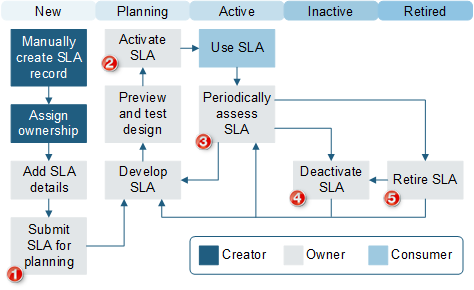SLA Lifecycle
Diagram describes the high-level SLA lifecycle in the OOTB system.

| 1 | A One-Step™ Action changes the status to Planning. |
| 2 | A One-Step Action changes the status to Active. |
| 3 |
When periodically assessing, the Owner can revise, deactivate, or retire a SLA.
|
| 4 |
When deactivated, the Owner can revise, reactivate, or retire a SLA.
|
| 5 |
When retired, the Owner can revise or reactivate a SLA.
|
Contributors
An SLA typically involves the following contributors. Depending on the workflow and the size of your company, the creator and owner might be the same person.
- Creator: User who creates the SLA. This is typically a member of the Services Team.
- Owner: User who manages the SLA. This is typically a member of the Services Team.
- Consumer: Person who uses the SLA. This is typically a Customer or User (technician) logging a record.
Phases
The SLA workflow is broken down into the following phases:
- New: Creator creates a new SLA and assigns ownership. Then, the owner defines the initial details and submits the SLA for planning/development.
- Planning (Development): Owner develops the SLA, including Target Times and Priority Matrix Elements. When ready, the owner activates the SLA.
- Active: SLA is operational in a live environment. Owner periodically assesses the SLA (SLA can be sent back for review/rework or retired if necessary).
- Inactive: SLA is temporarily out of use. Owner periodically assesses the SLA (SLA can be sent back for review/rework or retired if necessary).
- Retired: Expired/out-of-date SLA is retired. Owner can send the SLA back for review/rework, if necessary.